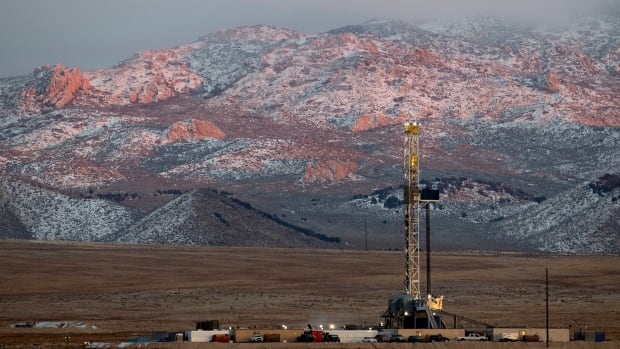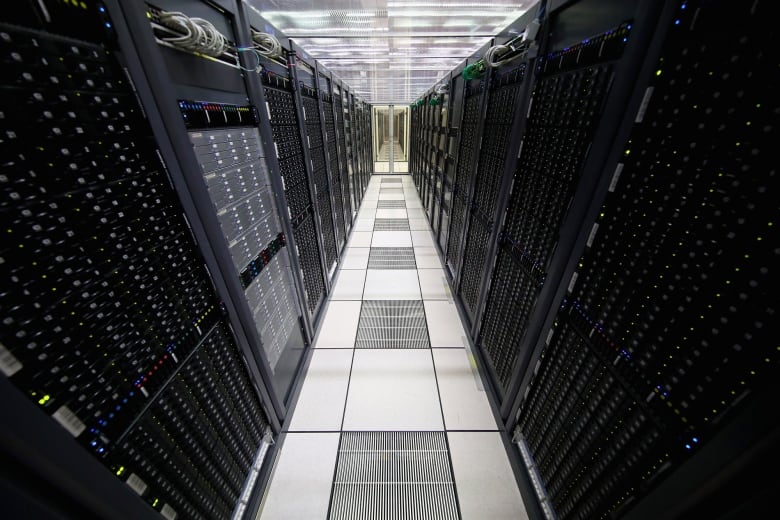
Using AI can feel like watching a magic trick.
Ask ChatGPT for a photo and out it comes, no matter how elaborate or goofy the request.
But behind the scenes are servers furiously working to power the technology — and using a lot of energy to do it.
According to some estimates, the average ChatGPT query takes about 10 times more power than a Google search, and generating an image takes about as much as charging a smartphone.
Depending where that power comes from, some warn the growth of AI could mean a massive spike in fossil fuel-related emissions. According to investment bank Goldman Sachs, carbon dioxide emissions from data centres could more than double between 2022 and 2030.
But some experts say the news isn’t all bad, and that growing demand for energy to power AI is also fuelling development of alternative forms of energy — from wind and solar to geothermal and nuclear — that could help propel the energy transition.
The drain

With demand projected to rise for AI, tech companies are plowing big money into data centres: the mega-warehouses full of servers, routers and cooling systems needed to power the technology.
The top 5 U.S. companies spending the most aggressively on AI forked over $105 billion in 2023 on data centres, and that’s expected to rise to $187 billion in 2028, Bloomberg News has reported.
Globally, power demand from data centres is expected to grow 160 per cent by 2030, according to the Canada Energy Regulator.
All this power needs to come from somewhere, and tech companies are balancing a range of priorities when they decide how to source it, said Ed Crooks, vice-chair for the Americas with Wood Mackenzie. They want it to be cheap, reliable and as environmentally friendly as possible given many of these companies’ climate pledges.
“It’s not easy, often, to balance all those different objectives against each other,” said Crooks, speaking to CBC News on the sidelines of this week’s Energy Disruptors conference in Calgary.
LISTEN | The Cost of Living looks at the cost of AI:
Cost of Living8:49The world is hooked on AI, but AI is addicted to energy
Sit down at a computer and within seconds you can generate an image of you dunking over Lebron on the moon. Fun, right? But it comes with a cost. Paul Haavardsrud looks at why our robot overlords ending humanity isn’t the only worry that comes with the rise of Artificial Intelligence. (Originally aired June 2, 2024)
In the near term, he said, the easiest way to hit the first two objectives is often with gas-fired power plants. And in the U.S., there’s lately been a major surge in plans to build new plants.
“[This] does have big problems because clearly power from a gas-fired power plant is not carbon-free and these companies all aim to be carbon-free,” he said.
The varying approaches to how AI companies might meet their massive demand for energy are evident in Canada, where the majority of data centres so far have been in provinces with abundant hydroelectricity. According to the Canada Energy Regulator, there are 105 in Ontario, 57 in Quebec and 35 in British Columbia.
Alberta, which relies on natural gas for most of its power, has 22 data centres, the regulator says. However, the province has been busy promoting itself as an ideal place to set up more, and industry interest is growing.
The number of applications received by the Alberta Electric System Operator (AESO) has increased in recent months, the agency recently told CBC, representing about 5,000 MW of data centre projects at the preliminary stages of development.
Using carbon capture facilities in tandem with natural gas plants is one way to reduce their carbon impact, though this can add costs when developing a project.
“It costs more to generate power [while using carbon capture]. Whether or not that’s effective from a business point of view for the industry is a question,” said Warren Mabee, director of the Institute for Energy and Environmental Policy at Queen’s University, in an interview.
The potential
But as tech companies scramble to get reliable sources of power up and running as soon as possible, they’ve also put big money into renewable and alternative sources of energy, even those that have high up-front capital costs, like geothermal.
For example, Google has built a first-of-its-kind geothermal power project in Nevada to power its nearby data centres, and expressed interest in using small modular reactors (SMRs) for a similar purpose.
Amazon has recently become the world’s top corporate buyer of solar and wind energy.
And Microsoft recently made headlines for announcing it had signed a power-purchase agreement that would restart the Three Mile Island nuclear power plant in Pennsylvania.
“We are advocating for more nuclear across the system,” said Jim Collins, who is in charge of Microsoft’s data centre energy strategy, speaking onstage at the energy conference.
As these tech companies build out alternative energy projects at scale, there’s hope that they can work out some of the kinks and drive costs down, making it easier for other companies to follow suit, said Keaton Horner, director of analytics with Orennia, a Calgary-based analytics company that helps companies transition to renewable and alternative energy sources.
“We could actually see folks like Microsoft start to invest heavily in these newer technology types of energy sources, get a few of them built, we learn along the way as we get more capacity added,” said Horner, pointing to SMRs as another example.
“Five to 10 years from now, those could be actually just cost-competitive with traditional sources of energy as we know them today.”
WATCH | Breaking down the climate impact of AI:
The energy needed to generate artificial intelligence leaves behind a sizable carbon footprint, but it’s also increasingly being used as a tool for climate action. CBC’s Nicole Mortillaro breaks down where AI emissions come from and the innovative ways the technology is being used to help the planet.
In the near-term, though, finding enough renewable energy to go around can be tricky. One much-hyped carbon removal megaproject in Wyoming was recently scrapped after the company behind the project reportedly said it faced too much competition for renewable energy from data centre operators and cryptocurrency miners.
“If you’re competing with a data centre for power on the grid, that’s a tough position to be in,” said Horner.
Can’t unring this bell
Crooks, with Wood Mackenzie, said it’s difficult to sum up AI’s impact as unequivocally good or bad for energy and climate.
But, he said, the fact of the matter is the technology can’t be uninvented. And he believes that as long as policymakers, regulators and customers alike push companies to invest in technology that drives decarbonization forward, it could eventually become a net positive.
“What AI does is it creates a power industry and energy industry that is looking for the future and looking to growth,” said Crooks.
“And I think, at the end of the day, that is going to make the energy transition more possible, is going to drive more progress than if we didn’t have AI.”
